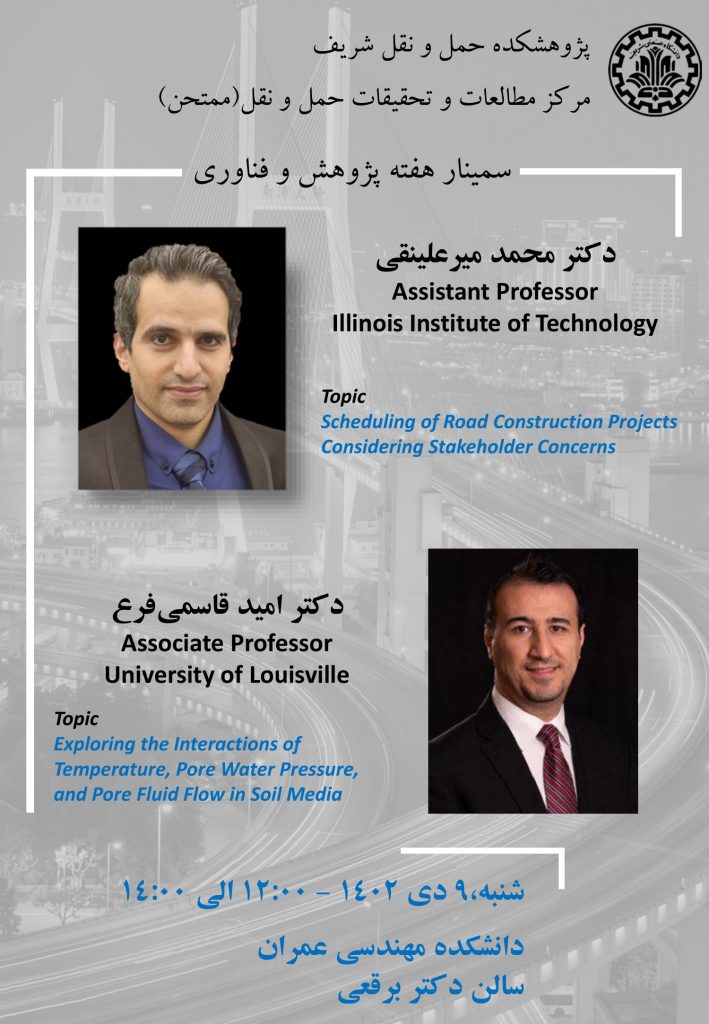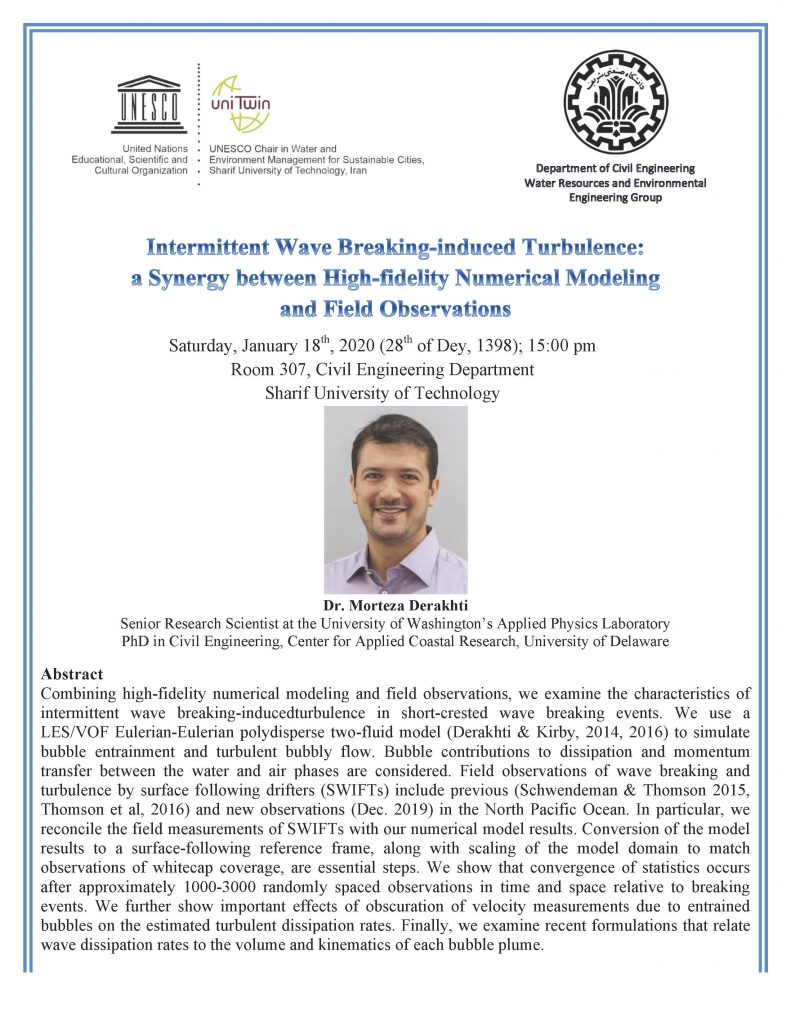

تارنمای معاونت پژوهشی دانشکده مهندسی عمران
تارنمای معاونت پژوهشی دانشکده مهندسی عمران


رده بندی قیر و اصلاح قیر در منطقه خاورمیانه
Bitumen Grading and Modification in the Middle East
با سخنرانی آقایان دکتر اِتزیو سانتاگاتا و دکتر ولید زیادَه،مدیریت جلسه با آقای دکتر حسین بهیا
چهارشنبه (27 ژانویه) 8 بهمن 1399، ساعت 16:30 تا 18:00 (به وقت ایران)
لینک ورود:
https://us.bbcollab.com/guest/ceaf6297b351426a85c930efd45b4077
نحوه ورود: آزاد و بدون نیاز به پسورد.
برای اطلاع از رئوس مطالب و بیوگرافی سخنرانان به لینک روبرو و یا فایل پیوست مراجعه شود: www.mesat.org
Introducing S-VECD Model Energy-Based Fatigue Failure Criterion and Its Applications to Reclaimed Asphalt Pavement (RAP) Mixtures
دکتر محمدرضا صبوری، دانشکده مهندسی عمران، دانشگاه صنعتی شریف
چهارشنبه 21 آبان 1399، ساعت 16:00 تا 17:30
لینک ورود: https://vc.sharif.edu/ch/civil-seminar
نحوه ورود: آزاد و بدون نیاز به پسورد، بر روی گزینه “میهمان” کلیک و نام خود را وارد کنید.
Abstract:
Fatigue cracking due to repeated traffic loading is one of the major types of distress in asphalt concrete pavements. Propagation of fatigue cracks in the asphalt layer will eventually allow water to come into the pavement system, and cause deterioration of pavement structure which reduces its serviceability. Hence, description and prediction of fatigue resistance of hot mix asphalt (HMA) in an accurate manner is extremely important to flexible pavement design and preservation. In this presentation, to predict the fatigue life of the pavements, a failure criterion for the simplified viscoelastic continuum damage (S-VECD) model, referred to here as GR method, is introduced. This failure criterion found to exist in both reclaimed asphalt pavement (RAP) and non-RAP mixtures and also found to be independent of the mode of loading, strain/stress amplitude, and temperature and also is effective in accurately predicting the fatigue life of the mixtures.
Biography:
Dr. Sabouri earned his bachelor’s and Master’s degrees in Civil Engineering from Sharif University of Technology, followed up by receiving his Doctoral degree on Transportation Materials and Systems from North Carolina State University. Dr. Sabouri is currently an Assistant Professor at Sharif University of Technology. Dr. Sabouri has several publications and invited presentations at many different national and international conferences including Association of Asphalt Paving Technologists (AAPT), Transportation Research Board (TRB), RILEM, ISAP, and NCCE. Dr. Sabouri’s research interests are generally focused on characterizing and performance modeling of pavement materials, pavement systems, pavement design and analysis, and development and implementation of sustainable engineered materials that are based on sound engineering principles and are less costly to produce.
DEVELOPMENT OF A PERFORMANCE-RELATED ASPHALT MIX DESIGN SPECIFICATION FOR THE ILLINOIS TOLLWAY
مهندس بهنام جهانگیری، کاندیدای دکترا در مهندسی عمران در روسازی و تکنولوژی آسفالت، دانشگاه میزوری، آمریکا
سه شنبه 11 شهریور 1399، ساعت 15:00 تا 16:30
لینک ورود:https://vclass.ecourse.sharif.edu/ch/civil-seminar
نحوه ورود: مجانی و بدون نیاز به پسورد، بر روی گزینه “میهمان” کلیک و نام خود را وارد کنید.
Bio:
Behnam Jahangiri is a PhD candidate in the Department of Civil and Environmental Engineering at the University of Missouri-Columbia (MU, Advisor: Bill Buttlar). He also holds an MSc degree in Pavement Engineering from Sharif University of Technology (Advisor: Nader Tabatabaee), and a BSc degree in Civil Engineering from Isfahan University of Technology. As a Graduate Research Assistant at Missouri Asphalt Pavement and Innovation Lab (MAPIL), he has been working on cutting-edge research areas related to smart infrastructure systems and innovative construction materials to address real-world concerns in the asphalt industry. Currently, his research is focused on the development of performance specifications for the Illinois Tollway. He is also involved in the characterization of a wide variety of modern and heterogeneous asphalt mixtures containing recycled materials RAP, RAS, rubber, and waste plastic for the Missouri Department of Transportation and for industry. Finally, he conducts research in advanced machine learning/artificial intelligence methods for material characterization, and deployment of sensors for civil infrastructure condition assessment.
Abstract:
In the past, traditional asphalt mixtures involved relatively simple combinations of virgin asphalt binder and aggregates to meet performance requirements. However, modern, heterogeneous asphalt mixtures exhibit more complex behavior due to proliferation of new ingredients and because of the interactions that subsequently occur. As a result, recent asphalt mixes require advanced performance tests to account for the effects of the added components, increased traffic loads, and prevailing environmental conditions. In this presentation, different mixtures produced in 2018 for the mainline and shoulder sections across Tollway system in Chicago were selected to characterize trends of the performance tests conducted on the new Tollway mixtures and to study the ability of different performance tests to predict pavement performance. To this end, performance tests were performed on the collected plant produced mixtures, and later, on selected field-cored sections. The latter included both good and poor performing sections, which were determined based on an extensive survey of the Illinois Tollway in May of 2019. Evaluation of Tollway asphalt surface pavement management data indicated excellent overall performance vs. time, with minor amounts of several cracking forms developing gradually over time. These included transverse cracking, usually associated with reflective cracking on the mainline and/or thermal and block cracking on shoulders, and longitudinal cracking (typically along the construction joint between lanes). Rutting, on the other hand, was not observed to be a significant form of distress on modern Tollway sections. The Disk-shaped Compact Tension (DC(T)) test was chosen to be retained in the performance related specification (PRS) for the design of crack-resistant mixtures because of its excellent repeatability and its high correlation with field results. A systematic approach was developed, which allowed different reliability levels to be addressed in the specification, along with a consensus step to take advantage of the experience of local practitioner.
مهندس سید محمد طبیب، مهندس ارشد بخش قیر و مواد قیری در MTO
چهارشنبه 5 شهریور 1399، ساعت 13:30 تا 15:00
لینک ورود:https://vclass.ecourse.sharif.edu/ch/civil-seminar
نحوه ورود: مجانی و بدون نیاز به پسورد – بر روی گزینه “میهمان” کلیک کنید و نام خود را وارد کنید.
Bio:
Seyed Mohammad Tabib, M.Sc., P.Eng. is a senior bituminous engineer with the Bituminous Section of the MTO. He completed a M.Sc. degree in 1996 from Sharif University of Technology in Transportation Engineering , majored in asphalt technology, and another M.Sc. in 2001 in Traffic Engineering from U of T. Seyed has a broad range of background experience in materials engineering and research, pavement, geotechnical, and traffic engineering in Ontario and overseas. He joined MTO in 2003 and has provided effective support to regional and head office programs ever since.
Seyed is a licensed engineer with the Professional Engineers Ontario (PEO). He has authored and co-authored several research papers in asphalt technology, pavement, and traffic engineering.
Abstract:
The Ministry of Transportation of Ontario (MTO) uses a PG plus specification to mitigate premature pavement cracking. Due to complex nature of the various asphalt mixture components and binder additives, testing the tank asphalt cement (AC) alone may not be sufficient and there is a need for testing post-production products for acceptance.
The MTO is evaluating various asphalt mix performance tests with the goal to establish acceptance criteria for post-production asphalt mix that relates to long term pavement performance (i.e., to achieve a balance between resistance to cracking and rutting). Loose asphalt mix and pavement cores were collected and tested from various paving contracts using the following tests:
• Flexibility Index Test (FIT)
• Disk-Shaped Compact Tension (DC(T)) test
• Hamburg Wheel Tracking (HWT) test
Work to date has revealed that, in general, these tests were able to differentiate asphalt mixes based on PGAC, asphalt mix type, and presence of RAP.
MTO has also evaluated cores taken from good and poor performing pavements 5-13 years old using FIT and DC(T) tests and obtained reasonable results. Both recovered AC grading and mix performance tests are considered effective tools in evaluating pavement performance.
This presentation will provide an overview of the test procedure, results, and preliminary threshold values for acceptance of post-production asphalt mixes.
ِDr. Morteza Derakhti
Senior Research Scientist at the University of Washington’s Applied Physics Laboratory PhD in Civil Engineering, Center for Applied Coastal Research, University of Delaware
